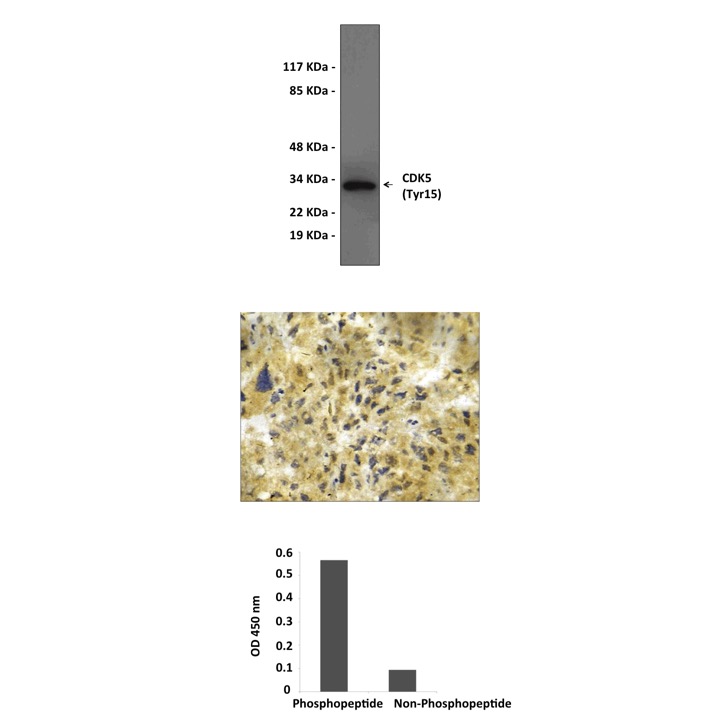Product Sheet CG1085
Description
BACKGROUND Cdks (Cyclin-Dependent Kinases) are heteromeric serine/threonine kinases that control progression through the cell cycle in concert with their regulatory subunits, the cyclins. Although there are 12 different cdk genes, only 5 have been shown to directly drive the cell cycle (Cdk1, -2, -3, -4, and -6).1 Following extracellular mitogenic stimuli, cyclin D gene expression is upregulated. Cdk4 forms a complex with cyclin D and phosphorylates Rb protein, leading to liberation of the transcription factor E2F. E2F induces transcription of genes including cyclins A and E, DNA polymerase and thymidine kinase. Cdk4-cyclin E complexes form and initiate G1/S transition. Subsequently, Cdk1-cyclin B complexes form and induce G2/M phase transition. Cdk1-cyclin B activation induces the breakdown of the nuclear envelope and the initiation of mitosis.2 Cdks are constitutively expressed and are regulated by several kinases and phosphastases, including Wee1, CDK-activating kinase and Cdc25 phosphatase. In addition, cyclin expression is induced by molecular signals at specific points of the cell cycle; leading to activation of Cdks.3 Tight control of Cdks is essential as misregulation can induce unscheduled proliferation, and genomic and chromosomal instability. Cdk4 has been shown to be mutated in some types of cancer, whilst a chromosomal rearrangement can lead to Cdk6 overexpression in lymphoma, leukemia and melanoma. Cdks are currently under investigation as potential targets for antineoplastic therapy, but as Cdks are essential for driving each cell cycle phase, therapeutic strategies that block Cdk activity are unlikely to selectively target tumor cells.4
Cdk5 is a member of the cyclin-dependent kinase family. It interacts with D1 and D3-type G1 cyclins and is probably involved in the control of the cell cycle. However, it is unique in several aspects. First, it is activated by the neural-specific non-cyclin activators p35 and p39. Secondly, Cdk5 is implicated in neuronal migration, synapse functions/maintenance, and neuronal survival. CDK5 phosphorylates a diverse list of substrates including histone H1, tau, MAP2 and NF-H and NF-M, implicating it in the regulation of a range of cellular processes from adhesion and motility, to synaptic plasticity and drug addiction. Recent evidence indicates that deregulation of this kinase is involved in the pathology of neurodegenerative diseases.5 Phosphorylation of Cdk5 by c-Abl occurs on Tyr15, which is stimulatory for p35/Cdk5 kinase activity.6
REFERENCES
1. Pestell, R.G. et al: Endocrine Rev. 20:501-34, 1999
2. Nurse, P.: Cell 100:71-8, 2000
3. Morgan, D. O.: Ann. Rev. Cell Develop. Biol. 13:261-91, 1997
4. McDonald, E.R. 3rd. & El-Deiry, W.S.: Int. J. Oncol. 16:871-86, 2000
5. Dhavan, R. & Tsai, L.H.: Nature Rev. Mol. Cell Biol. 2:749-59, 2001
6. Zukerberg, L.R. et al: Neuron 26:633-46, 2000
2. Nurse, P.: Cell 100:71-8, 2000
3. Morgan, D. O.: Ann. Rev. Cell Develop. Biol. 13:261-91, 1997
4. McDonald, E.R. 3rd. & El-Deiry, W.S.: Int. J. Oncol. 16:871-86, 2000
5. Dhavan, R. & Tsai, L.H.: Nature Rev. Mol. Cell Biol. 2:749-59, 2001
6. Zukerberg, L.R. et al: Neuron 26:633-46, 2000
Products are for research use only. They are not intended for human, animal, or diagnostic applications.

(Click to Enlarge) Top: Western blot analysis of extracts from COS-7 cells treated with 200 ng/mL EGF for 30 minutes and HEK 293 cells treated with 100 μM H2O2 for 15 minutes. Middle: Immunohistochemistry analysis of paraffin-embedded Human ovary carcinoma. Bottom: ELISA for Immunogen Phosphopeptide (left) and Non-Phosphopeptide (right).
Details
Cat.No.: | CG1085 |
Antigen: | Range AA1 to 30 |
Isotype: | Rabbit IgG |
Species & predicted species cross- reactivity ( ): | Human, Mouse, Rat |
Applications & Suggested starting dilutions:* | WB 1:500-1:1000 IP n/d IHC 1:50-1:100 ICC n/d FACS n/d ELISA 1:5000 |
Predicted Molecular Weight of protein: | 33 KDa |
Specificity/Sensitivity: | Detects endogenous Cdk5 proteins without cross-reactivity with other family members. |
Storage: | Store at -20°C, 4°C for frequent use. Avoid repeated freeze-thaw cycles. |
*Optimal working dilutions must be determined by end user.
Products
| Product | Size | CAT.# | Price | Quantity |
|---|---|---|---|---|
| Rabbit Cyclin-Dependent Kinase 5, Phospho-Tyr15 Antibody: Rabbit Cyclin-Dependent Kinase 5, Phospho-Tyr15 Antibody | Size: 100 ul | CAT.#: CG1085 | Price: $384.00 |
Resources/Documents
Publications
2015
Morey, T., R. Roufayel, D. Johnston, A. Fletcher and D. Mosser. 2015. Heat Shock Inhibition of CDK5 Increases NOXA Levels through miR-23a Repression. J Biol Chem, 290:11443-11454.
Roufayel, R. Regulation of Heat-Induced Apoptosis by Loss of miR-23a-Dependent Control of Noxa in Human Cells and its Suppression by HSP70. PhD Thesis, The University of Guelph.
